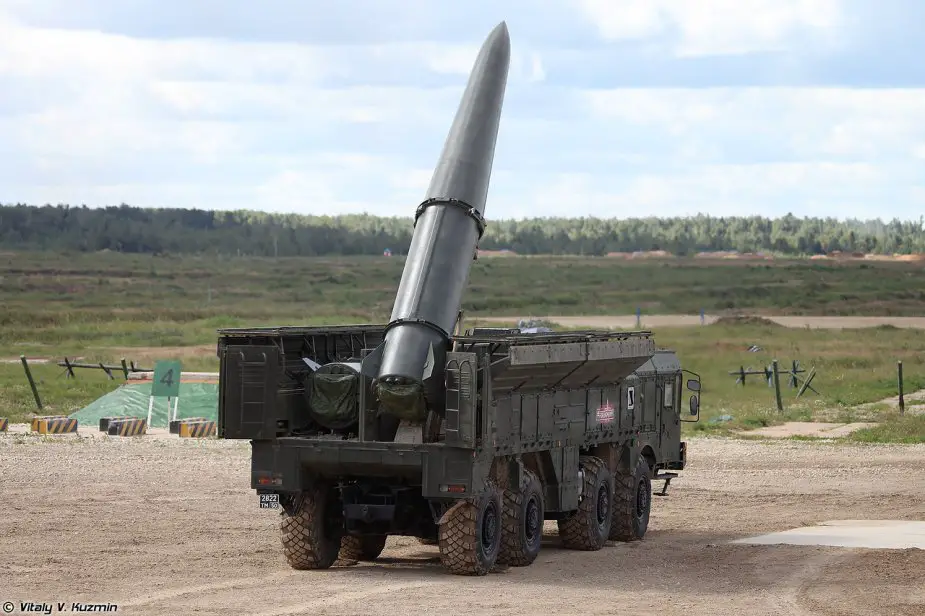The Defense Ministry reported a test launch of an Iskander ballistic missile. The launcher of the Eastern Military District hit an important target at Kapustin Yar range. The launch is likely the beginning of a large-scale series of missile tests that will last up to mid-September at Sary-Shagan and Kapustin Yar ranges, the Military-Industrial Courier writes.

9P78-1 TEL of 9K720 Iskander-M SRBM (Picture source: Vitaly Kuzmin)
President Vladimir Putin ordered to test launch Russian missiles in response to the first trials of the ground-based Tomahawk. So far, it is unclear which missiles will be fired. The Defense Ministry is rarely disclosing new launches, so it is possible only to suggest what will be tested at Sary-Shagan and Kapustin Yar. In late August - early September, Russia issued several Notices To Air Men (NOTAM) which closed Kapustin Yar and Sary-Shagan ranges. The areas are constant no-fly zones, but this time the Defense Ministry closed a much broader area. The first NOTAM was issued on August 30-31 and others followed in September. There will be six one-day NOTAMs in September. Kapustin Yar is a historic place for missile tests. It has a center to retrain the military for new weapons.
Sary-Shagan was a missile defense range which was later used to test new re-entry vehicles of ballistic missiles. The measuring equipment of the range precisely tracks the vehicles re-entering the atmosphere. The data are used by designers to upgrade the units. Kapustin Yar - Sary-Shagan duo has long been used to test sophisticated missiles. In contrast to Kura in Kamchatka, their location does not allow foreign military to track missile launches and obtain important information.
However, there is a disadvantage: the distance between the ranges is less than 1,000 kilometers and it is impossible to launch ballistic missiles between them. The Soviet Union used several special test missiles to deliver re-entry vehicles to Sary-Shagan. At present, Topol-E is used for that. The first NOTAM of August 30-31 is invalid already. On August 30, the 3rd missile brigade test fired an Iskander air ballistic missile. It looked like an ordinary launch, but the Defense Ministry said on its website that the missile flew by a "quasi-ballistic trajectory." The official footage of the launch shows the missile doing occasionally complicated maneuvers in altitude and flight direction. It means it was not flying along a genuine ballistic trajectory. Such maneuvering complicates interception. NOTAM was issued with an unusually broad no-fly zone. It is not ruled out that Iskander for the first time accomplished new maneuvers.
The route between Sary-Shagan and Kapustin Yar is convenient for trials of short and intermediate-range missiles. Which missile was fired? It was hardly a ground-based cruise missile, as it can be tested at Kapustin Yar without engaging Sary-Shagan and its sophisticated measuring equipment. Kapustin Yar has the necessary test base. The line of Iskander missiles was upgraded for batch production there. If the talk is about short and intermediate-range missiles, they are likely air ballistic and ballistic units. The first launches of hypersonic Kinzhal missile are likely. It has much in common with air ballistic Iskander. The ground-based Kinzhal has little to complement for successful operation.
The second option is a test of renewed Rubezh RS-26 missile. It is one of the most mysterious weapons in the line of Russian missiles. It has been reported several times that it would be accepted into service, but it did not happen so far. The tactical and technical characteristics of Rubezh have not been officially disclosed. It is presumably a small ballistic missile with a shorter range of six thousand kilometers. Small modifications can develop it into an intermediate missile. Sary-Shagan range is good for its trials as its equipment can monitor the flight.
The mentioned missiles might not have been developed had the United States remained in the Intermediate-Range Nuclear Force (INF) Treaty. The withdrawal undermines the basics of global security. In such a situation Russia has to urgently find an adequate and effective response, the Military-Industrial Courier writes.
© Copyright 2019 TASS / Army Recognition Group SPRL. All rights reserved. This material may not be published, broadcast, rewritten or redistributed.















